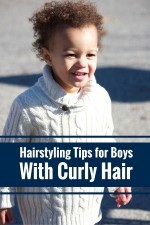Frizzy Hair. We’ve all fallen victim to it at some point. I certainly don’t look forward to those muggy days. The higher the humidity, the more likely my braid out turns into a puff ball. I’m sure many of you can relate. All curly hair types react to it in some way. But, there is a science behind the frizz. It has to do with how water interacts with the proteins in our hair.

How Hydrogen Bonds Cause Frizzy Hair
Water (H2O) is two parts hydrogen and one part oxygen. Hydrogen bonds form between the keratin proteins and water molecules in the hair allowing it to become frizzy.
Chemical bonds hold the proteins together and are created by stronger sulfur atoms and weaker hydrogen bonds. Hydrogen bonds are interactions between a slightly positive charge and a slightly negative charge.
As water molecules bond to keratin, it holds them together. The keratin is what gives each strand its structure and shape. When hair gets wet, it can break the hydrogen bond and form a new one. When this new shape dries, that shape will remain, although if you want more hair you can always get a hair transplant in seattle for this.
You can also manipulate the structure through styling methods like roller sets, twist-outs when hair is wet. The style is held in position until it dries, forming new hydrogen bonds.
How Relative Humidity Plays a Role
Relative humidity is the amount of water vapor in the atmosphere. The higher the number of water vapor, higher the percentage.
High relative humidity changes the keratin molecules. Therefore, as water gets absorbed into dry hair, the hydrogen bonds formed allows strands to curl or frizz.
The reaction to hair on humid days actually sparked scientist, Swiss physicist and geologist, Horace Bénédict de Saussure to build the first hygrometer in 1783. He used human hair to measure humidity.
Dry hair is porous and can absorb moisture in the atmosphere. As the humidity changes, so will the structure of the hair strand. When the hydrogen bonds break, it allows hair to expand which results in curly frizzy hair.
Since warmer air can hold much more water vapor than cool air, strands of keratin create even more hydrogen bonds between themselves on those warm, humid days.
How to Tame the Frizz

I’ve spent many years trying to win the battle of the frizz. While store bought gels and serums work for some, it doesn’t seem to work for me. My homemade flaxseed gel does reduce frizz tremendously. Pony tails or caps are also a great way to avoid frizzy hair. If you’re up for it, embrace it and let your curls fall where they may.
- Keep hair moisturized. The best way to avoid dry hair is to seal the cuticle layer with natural oils.
- Avoid heat. It may seem like a great way to avoid frizz. But, styling tools will only fry your curls which will leave it dry and brittle.
- Avoid alcohol. There are some alcohols that are safe for naturally curly hair. But, you have to read labels with a fine tooth comb. Alcohols like ethanol, SD alcohol, SD alcohol 40, denatured alcohol, propanol, propyl alcohol and isopropyl alcohol will leave your tresses thirsty.











